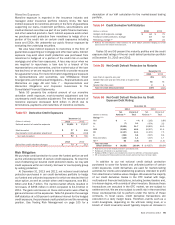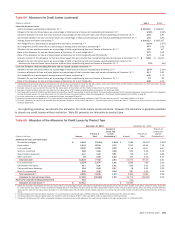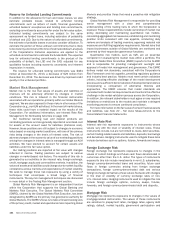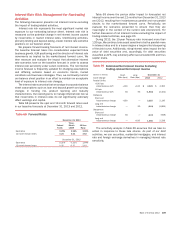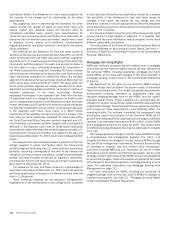Bank of America 2013 Annual Report Download - page 106
Download and view the complete annual report
Please find page 106 of the 2013 Bank of America annual report below. You can navigate through the pages in the report by either clicking on the pages listed below, or by using the keyword search tool below to find specific information within the annual report.104 Bank of America 2013
Reserve for Unfunded Lending Commitments
In addition to the allowance for loan and lease losses, we also
estimate probable losses related to unfunded lending
commitments such as letters of credit, financial guarantees,
unfunded bankers’ acceptances and binding loan commitments,
excluding commitments accounted for under the fair value option.
Unfunded lending commitments are subject to the same
assessment as funded loans, including estimates of probability
of default and LGD. Due to the nature of unfunded commitments,
the estimate of probable losses must also consider utilization. To
estimate the portion of these undrawn commitments that is likely
to be drawn by a borrower at the time of estimated default, analyses
of the Corporation’s historical experience are applied to the
unfunded commitments to estimate the funded EAD. The expected
loss for unfunded lending commitments is the product of the
probability of default, the LGD and the EAD, adjusted for any
qualitative factors including economic uncertainty and inherent
imprecision in models.
The reserve for unfunded lending commitments was $484
million at December 31, 2013, a decrease of $29 million from
December 31, 2012. The decrease was driven by improved credit
quality in the unfunded portfolio.
Market Risk Management
Market risk is the risk that values of assets and liabilities or
revenues will be adversely affected by changes in market
conditions. This risk is inherent in the financial instruments
associated with our operations, primarily within our Global Markets
segment. We are also exposed to these risks in other areas of the
Corporation (e.g., our ALM activities). In the event of market stress,
these risks could have a material impact on the results of the
Corporation. For additional information, see Interest Rate Risk
Management for Nontrading Activities on page 109.
Our traditional banking loan and deposit products are
nontrading positions and are generally reported at amortized cost
for assets or the amount owed for liabilities (historical cost).
However, these positions are still subject to changes in economic
value based on varying market conditions, with one of the primary
risks being changes in the levels of interest rates. The risk of
adverse changes in the economic value of our nontrading positions
arising from changes in interest rates is managed through our ALM
activities. We have elected to account for certain assets and
liabilities under the fair value option.
Our trading positions are reported at fair value with changes
reflected in income. Trading positions are subject to various
changes in market-based risk factors. The majority of this risk is
generated by our activities in the interest rate, foreign exchange,
credit, mortgage, equity and commodities markets. In addition, the
values of assets and liabilities could change due to market liquidity,
correlations across markets and expectations of market volatility.
We seek to manage these risk exposures by using a variety of
techniques that encompass a broad range of financial
instruments. The key risk management techniques are discussed
in more detail in the Trading Risk Management section.
Global Markets Risk Management is an independent function
within the Corporation that supports the Global Banking and
Markets Risk Executive. The Global Markets Risk Committee
(GMRC), chaired by the Global Markets Risk Executive, has been
designated by ALMRC as the primary risk governance authority for
Global Markets. The GMRC’s focus is to take a forward-looking view
of the primary credit, market and operational risks impacting Global
Markets and prioritize those that need a proactive risk mitigation
strategy.
Global Markets Risk Management is responsible for providing
senior management with a clear and comprehensive
understanding of the trading risks to which the Corporation is
exposed. These responsibilities include ownership of market risk
policy, developing and maintaining quantitative risk models,
calculating aggregated risk measures, establishing and monitoring
position limits consistent with risk appetite, conducting daily
reviews and analysis of trading inventory, approving material risk
exposures and fulfilling regulatory requirements. Market risks that
impact businesses outside of Global Markets are monitored and
governed by their respective governance functions.
Quantitative risk models, such as VaR, are an essential
component in evaluating the market risks within a portfolio. The
Enterprise Model Risk Committee (EMRC) reports to the ALMRC
and is responsible for providing management oversight and
approval of model risk management and governance. The EMRC
defines model risk standards, consistent with the Corporation’s
Risk Framework and risk appetite, prevailing regulatory guidance
and industry best practice. Models must meet certain validation
criteria, including effective challenge of the model development
process and a sufficient demonstration of developmental evidence
incorporating a comparison of alternative theories and
approaches. The EMRC ensures that model standards are
consistent with model risk requirements and monitors the effective
challenge in the model validation process across the Corporation.
In addition, the relevant stakeholders must agree on any required
limitations or restrictions to the models and maintain a stringent
monitoring process to ensure continued compliance.
For more information on the fair value of certain financial assets
and liabilities, see Note 20 – Fair Value Measurements to the
Consolidated Financial Statements.
Interest Rate Risk
Interest rate risk represents exposures to instruments whose
values vary with the level or volatility of interest rates. These
instruments include, but are not limited to, loans, debt securities,
certain trading-related assets and liabilities, deposits, borrowings
and derivatives. Hedging instruments used to mitigate these risks
include derivatives such as options, futures, forwards and swaps.
Foreign Exchange Risk
Foreign exchange risk represents exposures to changes in the
values of current holdings and future cash flows denominated in
currencies other than the U.S. dollar. The types of instruments
exposed to this risk include investments in non-U.S. subsidiaries,
foreign currency-denominated loans and securities, future cash
flows in foreign currencies arising from foreign exchange
transactions, foreign currency-denominated debt and various
foreign exchange derivatives whose values fluctuate with changes
in the level or volatility of currency exchange rates or non-
U.S. interest rates. Hedging instruments used to mitigate this risk
include foreign exchange options, currency swaps, futures,
forwards, and foreign currency-denominated debt and deposits.
Mortgage Risk
Mortgage risk represents exposures to changes in the values of
mortgage-related instruments. The values of these instruments
are sensitive to prepayment rates, mortgage rates, agency debt
ratings, default, market liquidity, government participation and



